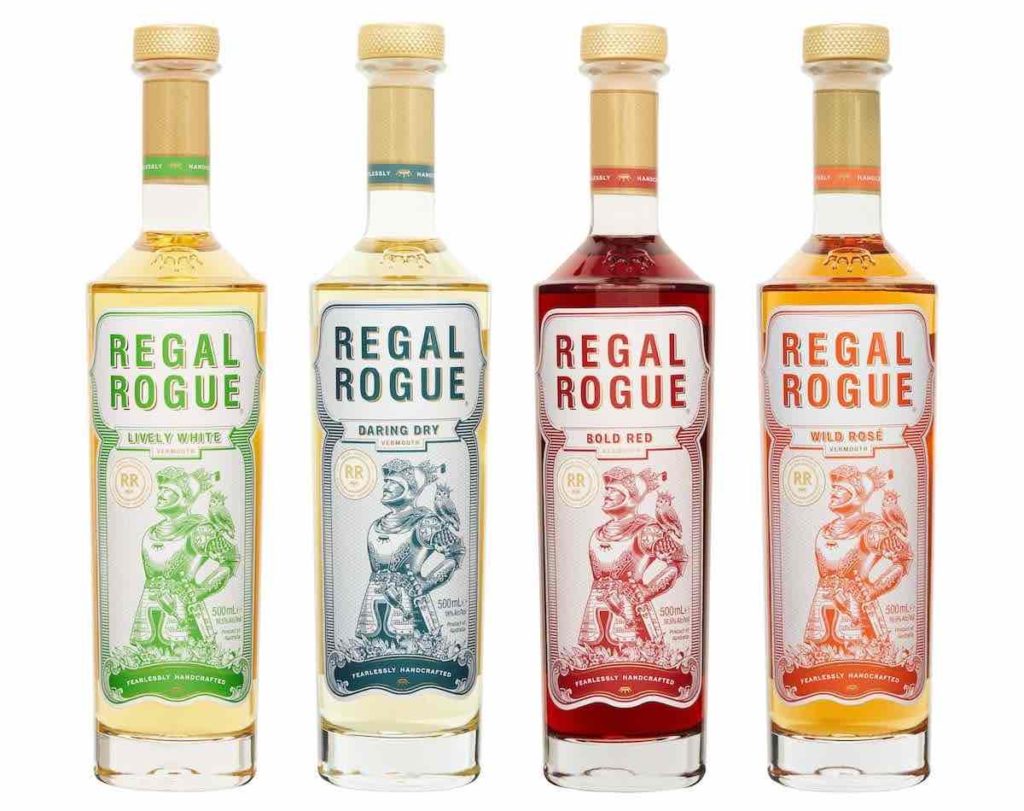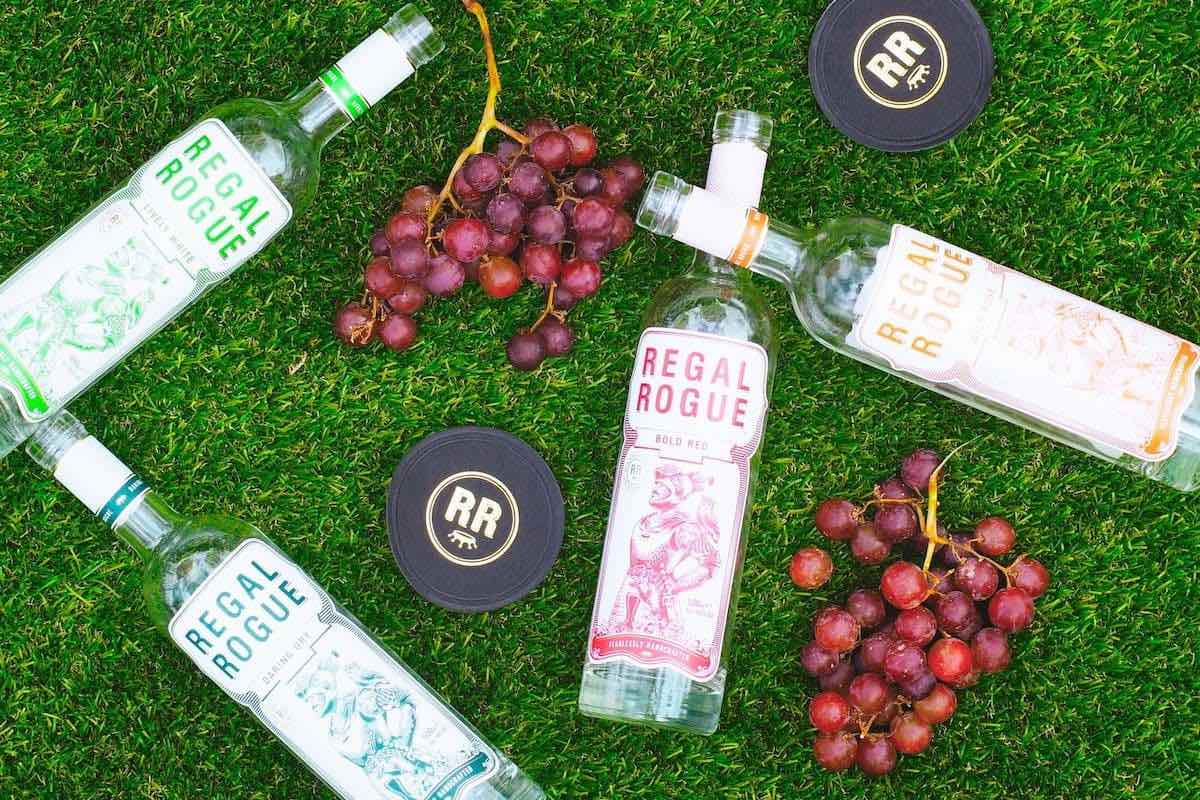I will never pretend to be a wine expert. In fact, when I’m stuck between labels in the wine aisle there’s a perfectly nonsensical rule I fall back on: Always pick the bottle with the knight.
By that logic, Regal Rogue already has a lot going for it. Not because it’s a line of vermouths made from organic Australian wine and native Australian herbs and spices, but because each of its four expressions features a proud-looking knight on the label.
Despite this, I did my best to try each expression—Bold Red, Wild Rosé, Lively White, and Daring Dry—impartially and record my results. Here’s what I found.
Regal Rogue Bold Red
Described by the brand as “semi-dry,” RR’s bold red is made with shiraz and unoaked chardonnay and counts native pepper berry, native thyme, wattleberry, cinnamon, clove, star anise, nutmeg, ginger, bitter orange, dried fig, and dried cherry among its botanicals.
In a welcome show of transparency, the bottles list the amount of sugar used in each expression. In this case, it’s 80 grams per liter, which the brand says is 64% less than the category standard.
The vermouth has a rather jammy nose, with blackberry and raspberry jam accompanied by fresh green strawberries and stewed pears. All-in-all, an aroma of cooked, mashed-fruit sweetness.
It is very light in body—and strikingly dry—but leads with light, bright fruit flavors including juicy peach and unripe strawberry. Blackberry jam kicks in at the middle, where it begins to grow more astringent with tart raspberry. The dryness reaches its apex at the finish, where a slight herbaceousness provides a strawberry-basil effect.
Regal Rouge Bold Red is a great contrast of light dryness and bright fruit. It’s quite a departure from the rich, powerful Italian vermouths like Carpano Antica. Perhaps because of this, the brand recommends making a “Rogroni,” which is simply a Negroni with Aperol in the place of Campari (and naturally, with Bold Red as the vermouth). It proved to be a worthy Negroni variant. The lightness of Aperol assured that the Bold Red wasn’t drowned out, and the vermouth in turn helped to dry out the Aperol while amplifying its light fruit flavors.
I also tried it in a regular Negroni. To my surprise, it wasn’t overshadowed and contributed pleasant fruit flavors up front. The juniper burn—I used Beefeater—perhaps felt more prominent whereas a stronger, sweeter vermouth might have dulled it. Ultimately, I’d still rely on a more traditional Italian Vermouth to make my Negronis, but the drink was enjoyable.
★★★
Stats:
— 16.5% ABV
— $19.99 (500 mL)

Regal Rogue Wild Rosé
Also described as semi-dry, the Wild Rosé is built from cabernet rosé, native illawarra plums, rosella, strawberry gum, fruit spice, rhubarb, and kina. It contains 70 grams of sugar per liter.
The Rosé’s nose is clean, fruity, and sharp, with an emphasis on stone fruits, chiefly apricot and peaches, as well as a touch of strawberry. There’s also a whiff of bitterness that puts it a little closer in nose to a traditional vermouth.
It is light and exceedingly dry on the palate, with jammy and sweet flavors of apricot and peach to start. It turns to raw honey and green strawberries at the center before peach returns at the home stretch, this time juicier and sweeter. The peach flavor lingers through a long, dry finish, even as an element of Kina leaps up to supply the bitterness you’d more typically expect from vermouth.
The contrast of juicy fruit and bitter kina works out wonderfully, and it proves highly enjoyable when mixed one-to-one with soda water.
★★★
Stats:
— 16.5% ABV
— $19.99 (500 mL)
Regal Rogue Lively White
Lively White has a nose that’s sharper and drier than the rest, which seems to put it more squarely into traditional vermouth territory. While you can pick up the whiff of bitter herbs there’s also peach and strawberry to contend with.
Palate wise, it starts dry, green, and slightly bitter with thyme before working its way up to the sweet flavors of peach and strawberry followed by floral notes of honeysuckle and raw honeycombs. Those sweeter notes turn to orange marmalade at the back, and crescendo with candied ginger. A light ginger spice accompanies its dry finish beside a slice of raw honey.

While I enjoyed the Lively White on its own, it also made a great companion to soda water.
Semi-dry Lively White features unoaked chardonnay plus native lemon myrtle, native thyme, desert limes, finger limes, elderflower, lemongrass, grapefruit, and chamomile. It contains 80 grams of sugar per liter, which RR says is 43% below the category average.
★★★
Stats:
— 16.5% ABV
— $19.99 (500 mL)
Regal Rogue Daring Dry
Described as extra-dry, Daring Dry is made with an organic sauvignon blanc, native anise, myrtle, native thyme, quandong, white pepper, gentian, olive leaf, and juniper. It contains just 25 grams of sugar per liter.
Daring Dry’s nose has some of the green strawberry, peach, and apricot notes I’d experienced in the others, alongside a light, tart raspberry. On the palate it starts with a faint peach and raspberry note that contributes a wispy, ghost-like sweetness. The middle brings out a sharp salinity like sea water with soft vegetal notes of green pepper, plus anise seed and light, dry spice.
The finish is bone-dry and lightly spiced with juniper notes evoking a soft gin, and the salinity progresses with a grainy, sea salt-like quality. This ultra-dry conclusion is finished off with a soft touch of peach, which made me imagine juicy slices of the stone fruit sprinkled with coarse sea salt.
I also tried it in a one-to-one Wet Martini with Beefeater Gin, in which it worked marvelously. The result was a Martini that wasn’t so juniper forward as it was salty, making it wonderfully savory, clean, and sharp. Because of the built-in dryness of the vermouth, it was a marvelous contradiction: a Wet-Dry Martini.
★★★
Stats:
— 18% ABV
— $19.99 (500 mL)
Final Thoughts
Regal Rogue styles itself as “The World’s First Quaffing Vermouth,” and while the statement seems easy to dismiss as cutesy brand-speak, I found that there’s some definite truth to the claim. All the Regal Rogues possessed a certain lightness and fruitiness that made them highly drinkable on their own, and a great match for soda water. But the dry aspect of each made them feel a little less like fortified wines and a bit closer to wine-wines, aka something I enjoyed sipping before, with, and after dinner each night.
Currently, Regal Rogue’s stateside distribution is limited to New York, but it is expected to reach more states in 2021.




Thank you Eric, great notes and I hope you’re still cherishing the tastes!
Mark Ward, Regal Rogue.